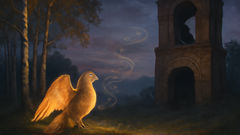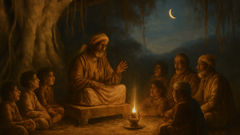Introduction
On the long northern shore where the land thins into ice and the sea remembers the sound of migrating wings, the elders spoke of two birds as if they were seasons themselves: the Alkonost, crowned with morning and gilded feathers, and the Sirin, wrapped in twilight and thin as a mourning shawl. They were not birds like those that nested in the pines or skimmed over the fishing boats; they were talismans of feeling, carriers of songs that could alter the contour of a life. People said the Alkonost nested at the edge of Paradise and rolled laughter like bright pebbles into the world, while the Sirin sat upon ruined towers and sang the memory of every lost day until listeners forgot to breathe. In certain villages, parents would hush children lest they draw a Sirin's attention; in others, newlyweds would listen for the Alkonost and call it a blessing. This is a story tangled with sea fog and spruce-scented dusk: an origin of voice and consequence, a map of where joy and sorrow can meet and where a human heart must choose. As the northern wind moves the dunes of memory, the Alkonost and the Sirin still sing—each a lesson in listening and a test of the will to live with what their music reveals.
Origins and the Songs
Long before the maps that men traced with ink and spindle existed, when rivers were known by the names of their first callers and not by traders’ ledgers, the world kept its balance by way of stories and sounds. Among those sounds were the voices of the Alkonost and the Sirin—voices said to have been born at the moment the first human felt joy and the first human felt grief. The oldest songs claim that when the first child laughed at the astonishment of snowfall, a winged creature gathered the brightness of that laugh and sewed it into a plumage of sunlit threads. That bird, the Alkonost, learned to sing joy into being; its music made fields yield earlier, wells sing clearer water, and hearts enlarge with tenderness. Where the Alkonost sang, people remembered birthdays they had forgotten; in the wake of its voice, communities rebuilt broken fences and shared bread with neighbors they had avoided.

In the same breath of myth came the Sirin. Born from the first deep sorrow—the soft, hollow ache when a mother’s child did not return from hunting—this bird's voice took the shape of a lament so pure and precise it cropped the edges of time. The Sirin’s song made the moon hang longer in the sky, and where it fell, people were compelled to listen. To listen was to feel every absence at once. Some versions of the tale tell of how the Sirin learned its tune from the long breath of the earth, the groan of birch roots pulling free from thaw; others claim it gathered the names of dead cities and wove them into a hymn that carried like ash. Unlike the Alkonost’s gathering of laughter, the Sirin gathered loss and made it radiant—and dangerous.
The two birds existed in a careful geometry: not opposite so much as complementary. They lived at borders—where the pinewoods met the frozen bay, where sunlight landed upon an abandoned bell tower. The Alkonost would descend from a place the elders called Dawn-Isle, where gulls were moved to inexplicable mirth by the first chords. The Sirin, by contrast, nested in ruins and on the shoulders of solitary graves, places where the living passed less often. Both were beautiful beyond measure. The Alkonost's eyes were like spun amber; its wings lent a warmth that made people unlace their coats in winter. The Sirin's gaze was a slow, deep water; those who watched it felt their histories unspooling and found the future a fragile thread.
What binds their myth to the human heart is not only beauty but consequence. The Alkonost's song was a ladder, and each rung invited one closer to the bright heights of remembered delight. It summoned gratitude, or so the storytellers insisted, and sometimes it infused the land with radical hope: fishermen recovered nets full of life after hearing it; widows found themselves humming to seedlings until green leaves answered. Yet even this bird's gifts carried a cost. Its music could become contagious—pulling someone from necessary mourning into premature joy, sealing over grief that deserved telling. The Sirin’s song, conversely, was a mirror that sharpened memory. It could honor loss, teaching communities how to hold scars without surrendering to despair. But when a Sirin's lament found a soul unprepared, it unstitched that skin of self. People who listened too long forgot how to move their hands, forgot to tie their boots, and would leave hearths cold and unlit. They would stand until the frost claimed them beneath the Sirin's final bar.
Rituals grew up like mushrooms after rain: songs to summon the Alkonost on planting days, and songs to ward off the Sirin on nights of storm. Villages built thresholds of birch and juniper; they hung tokens and feeds to attract a blessing without inviting a ruin. Priests of the old ways—women and men called by their neighbors border-keepers—learned songs that could answer either voice without being swallowed. They kept a ledger of names to speak aloud when a Sirin hovered, calling the dead by name so the lament could not collect them. In coastal hamlets, fishermen left bowls of porridge on cliff ledges to coax the Alkonost closer to bless the nets. There are accounts of a midwife who once held a newborn while an Alkonost rode the morning light into the kitchen window; the infant grew with a laugh that caught people by surprise and mended a quarrel between two families that had lasted ten winters.
Yet myth is not only practice but meeting: stories date moments when the birds sang to one another and then to a person who chose. Old maps record a place called the Mirror Quarry where the two birds were said to meet in a silence thick enough to cut with a knife. There, the Alkonost and the Sirin tested one another: the one would peel a song like a ray of sun, and the other would answer with a slow, minor chord of dusk. Those who came near could see the tug in the air—joy reaching to the dark, sorrow striving toward light—and some claimed what held them apart was not a rivalry but a conversation about how much of life should be remembered and how much reimagined.
Scholars who came later to collect these tales—scribes with flint pens and traders with notebooks—wrote that the birds were lessons in temperance. To live with Alkonost's music was to accept grace on the wind, to let beauty mend. To live with Sirin's was to carry grief without letting it cleave you. The ancient lawgivers told this in a language of balance: never lean so far into the Alkonost that your sorrow is smothered, never tilt wholly to the Sirin so that your days are only elegy. But of course, mortals are stubborn animals, and where there is a choice between immediate warmth and the slow fire of memory, decisions are made under moonlight and by candle, with hands that shake.
These origin-threads braided through festivals and lullabies, and through the art carved on household spoons: one side would carry an image of a bright bird, the other a darker silhouette. Parents would point to the spoons and say in something like a whisper: "Remember the songs. Not all beauty keeps you safe. Not all sorrow must break you." The Alkonost and Sirin thus remained ever present—part animal, part warning—singing across the centuries and shaping how people sang back.
The Choice of the Woods
There is a story within the story—an account told as often by hearth light as by scholars—that puts a human heart between the two birds. In a remote settlement where spruce leaned over the river and the ice broke late into spring, a young woman named Anya lived with hands that knew the slow arithmetic of tending and harvesting. She had lost a brother to a drifting canoe and a mother to fever; grief had laid its map across her face in small lines. Villagers said Anya carried her losses like talismans, leaving them on her windowsill to remind the world that she had been wronged and had survived. But she had a hunger afterward, not for forgetting but for meaning. She wanted a story large enough to hold what she had felt.

It was said that in the year Anya turned twenty-one, the birds flew low along the river. That spring had been lean: fish fewer, snow late, and a cough running through the sheep. People were brittle with worry. Anya, who kept neither priest's song nor trader's ledger, was restless in a way that has a name in fairy tales but fewer syllables in real life: she felt, with a kind of gentle mania, that if she could hear both birds she might stitch her history into a whole cloth. So she walked to the Mirror Quarry where old maps said the two met, carrying with her only a loaf, a flask of tea, and a small loom she had made to keep her hands steady.
The Quarry was not a place on any legal map; it was a fold in the earth where the wind would stop and seem to listen. When Anya arrived, twilight was a thin coin in the sky. She sat upon a stone that felt warm from the day and waited, and then the world gave up a sound: first the Alkonost, whose song arrived like rain of small gold coins. It filled the hollow with images—happy children chasing a skua, a harvest that had been imagined and then delivered, a woman laughing so hard she spilled tea onto her lap. Anya felt joy press at the seams of her ribcage, as if light tried to push outwards through her skin. Tears came, not from sadness but as an overflow of recognition.
Then the Sirin answered, and the air changed like a room whose floor had sloped. The Sirin's song was not a complaint but a remembering; it traced her brother's last moments with such fidelity that Anya could feel the cold water pull at her ankles, could taste the river's iron that had once been blood. Grief arrived not as chaos but as a slow, luminous clarity. The Sirin did not seek to drown her; it sought to teach her the names she had avoided—names of things left unsaid between her family as they dwindled into winter. As the lament unrolled, Anya understood that the song invited her to a ledger of truth: memory, unvarnished, offered as a gift and a wound.
Many would have fled at that moment. The birds' music could sever a person from the community—draw them into a trance at the mercy of their private sorrow. But Anya had learned, from years of mending nets and sewing the hems of linen, a kind of slow patience. Instead of recoiling, she sang back. Not with the Alkonost's bright trills nor with the Sirin's low-hung notes, but with a simple thread-song she had been told by her grandmother: a cadence made for naming. She named the river. She named the canoe. She named the brother's laugh and his silence. She named the fever that took the mother and the midwife who had not come in time. The naming was a small work, each syllable a stitch.
The Alkonost altered its arc and leaned in like a gull curious about a tide. The Sirin held its lament and softened, as if listening to the texture of Anya's voice and finding that grief could be cradled. For a time the three voices braided into something new: the Alkonost making room for warmth, the Sirin allowing mercy. The villagers who came later to tell the tale say that where the three-song braided, the earth took notice. There, moss grew quick and bright; where Anya set her hand upon a stone, a small sprig unfurled. Anya herself returned to the settlement with no miraculous cure or untold treasure, but with a new ledger on her tongue: the names of those she had loved, and the practice of saying them aloud. She taught the village the naming song. For years after, when grief arrived, people went to the Quarry not to be rescued but to name aloud what weighed them.
This account grew into ritual along the river. Those who needed the Alkonost's lift took small offerings of bread and cloth to the cliff's lip at dawn, and those who sought to honor loss left fresh water and a list of names at dusk so the Sirin might gather them without stealing the living. Children learned, in school and at play, to respect both voices. In the market the elder bakers told tales of a man who tried to trap the Sirin's song in a jar—he died trying, they said; the bird's lament slipped through the glass as wind slips through woven reed. Traders came and left with new carvings: birds on spoons, birds on combs, as if talismans could remind a person to listen and measure.
The story's power is not merely in the events but in the lesson stacked between them. The myth of Anya is not a promise that one can control grief or buy back joy; it is a record of a practice, of a human learning to hold different songs at once. It teaches that songs are not neutral—they rearrange reality. The Alkonost's music could render a bleak year soft enough to survive; the Sirin's could make the community learn the value of memory. Together they teach a kind of listening: to accept the timing of consolation, to let sorrow be named and not swallowed, and to admit that neither song is meant to dominate the other. A life lived with both songs is not contradictory; it is simply attentive.
Over centuries the tale thickened, and different versions cropped up: a fisherman who lost his sight after hearing a Sirin and later claimed he could see truths the rest of them could not; a poet who tried to mimic the Alkonost and nearly died from his own false joy. Such tales served as warnings and instruction manuals. People recorded them on birch bark and embroidered them into cloth—practical objects carrying myth. The birds became fixtures in folk songs, and although age and trade diluted some details, the core remained: there are voices that build and voices that unmake, and the only way through is by careful listening.
Even today, when the modern world hums with its own instruments and many no longer believe in birds that sing fate, the Alkonost and the Sirin remain alive in language and ritual. Valley choirs echo the idea of a song that heals; funerals incorporate melodies that sound like the Sirin but stop short of swallowing the living; festivals at the river offer bread not to a bird but to hope. The myth persists because it names a human predicament: how to balance celebration with sorrow, and how to learn that vulnerability to feeling is both a risk and a resource. In the end, Anya's choice—her willingness to sing names aloud between two birds—becomes a map for anyone who has to hold joy and grief in one shaking hand.
Conclusion
The Alkonost and the Sirin, like many stories people tell one another to keep the world legible, refuse a tidy moral. They do not ask you to choose joy or sorrow as though they were single fruits on a tree; they ask you to learn songs that let both pass through you without destroying what is left. In the villages by the northern shore, people still lean their ears toward the wind and hum the naming songs in the dark. They teach children to leave bowls on cliff-edges and to make lists of names in sealed books, not because magic is predictable, but because ritual trains the hand and steadies the heart. What the myth ultimately gives is a practice: a way to welcome light without erasing shadow, to honor loss without letting it become a permanent geography. The birds do what birds will—singing into the world and knowing nothing of human plans—but humans have learned, from the earliest days, that listening back matters. To remember the Alkonost and the Sirin is to remember how small acts—naming, offering bread, listening with deliberate attention—can change how a person moves through grief and joy. That is why the story endures, and why on certain evenings, standing on a cold shore or beneath a cedar's long arm, you might hear a thread of music and wonder whether the birds are near. If they are, listen closely; if they are not, remember the songs anyway. They will help you keep the parts of yourself that ache, and the parts that radiate, both alive.













